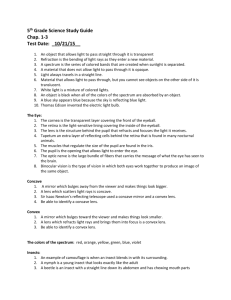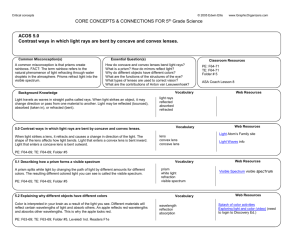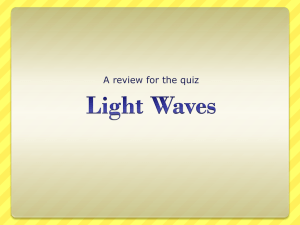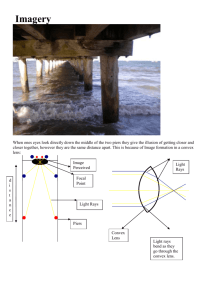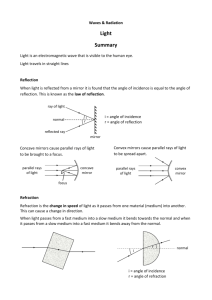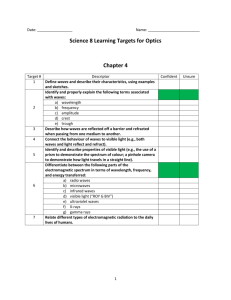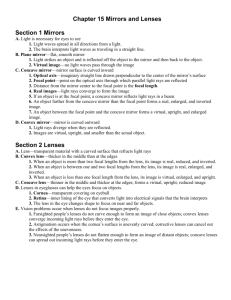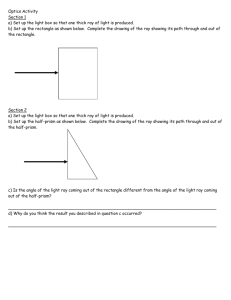File
advertisement
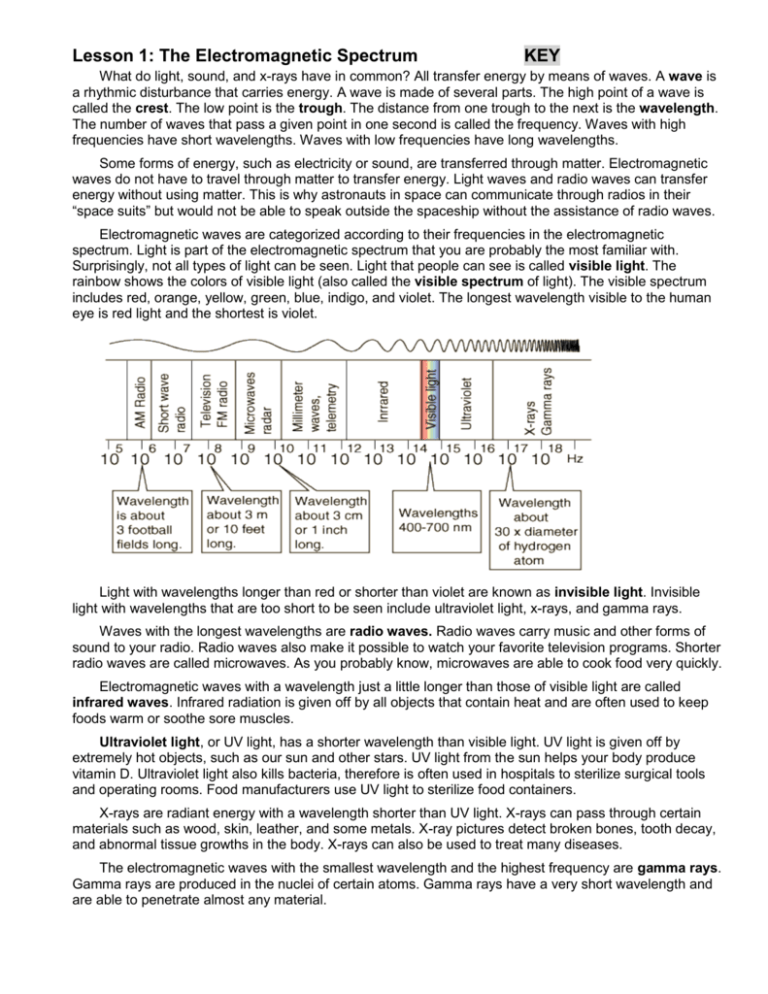
Lesson 1: The Electromagnetic Spectrum KEY What do light, sound, and x-rays have in common? All transfer energy by means of waves. A wave is a rhythmic disturbance that carries energy. A wave is made of several parts. The high point of a wave is called the crest. The low point is the trough. The distance from one trough to the next is the wavelength. The number of waves that pass a given point in one second is called the frequency. Waves with high frequencies have short wavelengths. Waves with low frequencies have long wavelengths. Some forms of energy, such as electricity or sound, are transferred through matter. Electromagnetic waves do not have to travel through matter to transfer energy. Light waves and radio waves can transfer energy without using matter. This is why astronauts in space can communicate through radios in their “space suits” but would not be able to speak outside the spaceship without the assistance of radio waves. Electromagnetic waves are categorized according to their frequencies in the electromagnetic spectrum. Light is part of the electromagnetic spectrum that you are probably the most familiar with. Surprisingly, not all types of light can be seen. Light that people can see is called visible light. The rainbow shows the colors of visible light (also called the visible spectrum of light). The visible spectrum includes red, orange, yellow, green, blue, indigo, and violet. The longest wavelength visible to the human eye is red light and the shortest is violet. Light with wavelengths longer than red or shorter than violet are known as invisible light. Invisible light with wavelengths that are too short to be seen include ultraviolet light, x-rays, and gamma rays. Waves with the longest wavelengths are radio waves. Radio waves carry music and other forms of sound to your radio. Radio waves also make it possible to watch your favorite television programs. Shorter radio waves are called microwaves. As you probably know, microwaves are able to cook food very quickly. Electromagnetic waves with a wavelength just a little longer than those of visible light are called infrared waves. Infrared radiation is given off by all objects that contain heat and are often used to keep foods warm or soothe sore muscles. Ultraviolet light, or UV light, has a shorter wavelength than visible light. UV light is given off by extremely hot objects, such as our sun and other stars. UV light from the sun helps your body produce vitamin D. Ultraviolet light also kills bacteria, therefore is often used in hospitals to sterilize surgical tools and operating rooms. Food manufacturers use UV light to sterilize food containers. X-rays are radiant energy with a wavelength shorter than UV light. X-rays can pass through certain materials such as wood, skin, leather, and some metals. X-ray pictures detect broken bones, tooth decay, and abnormal tissue growths in the body. X-rays can also be used to treat many diseases. The electromagnetic waves with the smallest wavelength and the highest frequency are gamma rays. Gamma rays are produced in the nuclei of certain atoms. Gamma rays have a very short wavelength and are able to penetrate almost any material. Lesson 1 Review: Circle the word below the statements that best completes the sentence. 1. A(n) _____________ is a rhythmic disturbance that carries energy. frequency wave magnet wavelength 2. The distance from one wave trough to the next wave trough is the ____________. frequency crest wavelength rhythm 3. The longest wavelength visible to the human eye is ______________ light. blue orange green none of the above 4. Light with wavelengths too short to be seen by the eye include ____________. UV light X-rays gamma rays all of the above 5. The electromagnetic waves with the longest wavelengths are ____________. radio waves X-rays gamma rays microwaves 6. ______________ are used to keep food warm and soothe sore muscles. X-rays infrared radio waves gamma rays 7. ______________ can kill bacteria. UV light radio waves X-rays 8. ______________ are produced in the nuclei of atoms. X-rays frequencies wavelengths gamma rays gamma rays Challenge Questions… 9. The color that corresponds to the shortest wavelength visible is _____________. red green violet all of the above 10. ______________ are used at airport security stations to detect hidden weapons in bags. radio waves X-rays infrared waves gamma rays Lesson 2: Reflection You can see an object only when light travels from that object to your eyes. For you to see this page, light must first strike the page and be reflected to your eyes. Reflection occurs when light strikes an object and bounces away from it. Nearly everything you see is reflected light. For example, when you stand in front of a flat mirror, you can see your own reflections and the reflections of objects around you. These images, or reflections, are upright but reversed from left to right. The reflections also appear as the same sizes as the objects that make them. They also appear to be as far away from the mirror as the actual objects. You can see yourself and the other images because almost all the light that strikes the mirror is reflected back to your eyes. How are these images produced? When light rays strike a flat mirror at an angle, they are reflected away at the same angle. The angle at which light rays strike a smooth surface is called the angle of incidence. The angle at which the rays bounce away from the mirror is called the angle of reflection. The angle of incidence always equals the angle of reflection. A sharp, clear image is formed only when light rays are reflected from a very smooth surface such as glass, still water, or polished metal. What happens when light strikes a rough surface? When light strikes a rough surface, the rays are reflected away in many directions. Not all mirrors are flat mirrors. A convex mirror is a mirror that is curved like the back of a spoon. Look at the back of a metal spoon. This surface is a convex mirror. Like a flat mirror, a convex mirror forms an upright image that appears to be behind the mirror. But unlike the image formed by a flat mirror, the image in a convex mirror is smaller than the object actually is. Convex mirrors are sometimes used as rearview mirrors in automobiles because they provide a wider field of view than flat mirrors produce. A caution statement is usually printed on these mirrors. Why? Images of the objects reflected in convex mirrors are smaller than the actual objects. Therefore, the objects appear to be much farther than they actually are. A concave mirror is a mirror that is curved like the bowl of a spoon. Light reflected from a concave mirror comes together at one place called the focal point, which is located in front of the mirror. The orientation and size of the image formed by a concave mirror depends upon the distance the object is from the mirror. The image might be upright or it may be upside down. It may be actual size or larger or smaller than the actual object. The image also appears to be either behind or in front of the mirror producing it. Describe your image as it appears in the bowl of a metal spoon. Common uses of concave mirrors are as reflectors in flashlights and car headlights. Reflecting telescopes use concave mirrors to collect light from the sky and project images of stars, planets, and other space objects. Lesson 2 Review: Determine if the statements below are true or false. Correct each false statement by crossing out the word or phrase that makes it false and by writing the correct word or phrase above it. __T___ 1. To see an object, light must first strike the object and then be reflected from it to your eyes. __F___ 2. An image in a flat mirror is always upside down. Right side up ___F__ 3. The angle at which light strikes a smooth surface is the angle of reflection. Incidence ___F__ 4. A sharp, clear image forms only when a light strikes a rough smooth surface. __T___ 5. A convex mirror is a mirror that is curved like the back of a spoon. smaller __F___ 6. The image formed by a convex mirror is always larger than the object that produces the image. ___T__ 7. A concave mirror is a mirror that is curved like the bowl of a spoon ___T__ 8. Concave mirrors are used as flashlight reflectors. Challenge Questions… ___F__ 9. Due to the behavior of light, you are NOT able to see yourself in a smooth blanket of snow ___T__ 10. Your image in the back of a metal spoon is always smaller than you are and is upright. Lesson 3: Refraction Light waves travel at different speeds through different materials. Light travels through space at the speed of 186,000 miles per second. Light slows down slightly when it passes through transparent matter such as air, water, or glass. When light rays pass from one transparent material to another, the rays are bent and change speed. Refraction is the bending of light rays that occurs when light passes through certain materials. Have you ever noticed that a straw in a glass of water appears to be bent? Light travels more quickly through air than through water. The slowing down of light rays makes the straw appear to bend where the air and water meet. In what other everyday situations can you observe the refraction of light waves as they travel through other materials? Light is refracted in instruments such as eyeglasses, microscopes, certain telescopes, and cameras through the use of lenses. A lens is any curved, transparent material that refracts light rays. Most lenses are made of either glass or plastic. There are two kinds of lenses: convex and concave. A convex lens is a lens that is thicker in the middle than it is at its edges. Recall that light travels in a straight line. When light enters a convex lens, the rays are refracted, or bent, toward the focal point, a place where the bent rays come together. Magnifying glasses, camera lenses, and the lens of your eyes are convex lenses. What if you held a magnifying glass near the wall directly opposite a window on a sunny day? If the lens is moved slowly away from the wall, the image of the window will be projected onto the wall. The image, however, appears upside down. A camera works the same way. Light rays passing through the shutter of the camera are refracted by the lens and focused onto the film. The image formed on the film is smaller than the object producing it and is upside down. A slide projector works on the same principle. To view slides so they are right side up on your screen, how should you insert them? Each of your eyes has a flexible, convex lens that focuses an image on the retina, a light-sensitive tissue that acts like the film in a camera. You can see the object only after its image has been converted into nerve impulses on your retina and transmitted to your brain. You can see an object clearly only if the image is focused exactly onto the retina. Many people have lens that are misshapen. When the lenses are not shaped correctly, the images are focused either in front or behind the retina, producing blurred images. When the images of distant objects form behind the retina, the eyes are farsighted. Farsighted people can focus clearly on objects far away from them. Farsightedness can be corrected with eyeglasses with convex lens. When the images of distant objects form in front of the retina, the eyes are nearsighted. Eyeglasses with concave lenses are used to correct this eye disorder. A concave lens is a lens that is thinner in the middle than at the edges. When light enters a concave lens, the light rays spread apart. Concave lenses cannot focus light. Lesson 3 Review: Circle the word below the statement that best completes the sentence. 1. Light travels through _________________ at 186,000 miles per second glass water air space 2. _________________ is the bending of light rays as they pass through certain materials. reflection magnification refraction imaging 3. Light is refracted in instruments such as_________________. camera lenses microscopes eyeglasses all of the above 4. _________________lenses are thicker in the middle than at at the edges. convex mirror concave nearsighted glasses 5. When light rays enter a convex lens, they are bent _________________ the focal point. toward away around 6. The image produced by a convex lens is _________________. upright blurred upside down all of the above 7. The light rays that enter a camera lens are focused on the _________________. retina film concave lens image 8. A(n) _________________ lens cannot focus light. convex concave camera telescope Challenge questions… 9. When standing waist deep in water, your legs look shorter because of _________________. water depth refraction of light as it enters the water reflection of light bouncing off the water 10. To have your vacation slides projected onto the screen in the upright position, you must put the slides into the projector _________________. upright upside down backwards Lesson 4: Color You probably recognize most objects by their shape and color. Two objects with identical shapes are easily distinguished from one another if they are different colors. For example, two of your neighbor’s cars may be the same make, model, and age you can tell at a glance that one is red and the other is blue. What IS color and how is it produced? Color is just one of the many properties of light. White light, or ordinary sunlight, is a mixture of many colors. White light can be separated into the visible spectrum with a prism. A prism is a transparent object that refracts, or bends light into the visible spectrum. The visible spectrum includes red, orange, yellow, green, blue, indigo, and violet, along with the many shades between those colors. Suppose you take a prism and hold it into a beam of sunlight. What happens? The prism refracts the sunlight and separates it into the seven main colors of the visible spectrum. The colors may also blend to for red-orange, blue-green, and others. A rainbow is formed in the same way. When tiny drops of water in the Earth’s atmosphere hang in the air after a rain, they act as prisms to refract sunlight into the colors of the visible spectrum. Each color of the spectrum refracts, or bends, at a different angle. Look at the picture on this page. Notice that violet light is refracted at a bigger angle than the red light. Is blue light refracted at a bigger or smaller angle than green? What if you held a convex lens in the path of the rays emerging from the prism? Recall that a convex lens is a lens that is thicker in the middle than at its edges. The convex lens converts the refracted, colored light back into parallel beams of white light. Then…why is the sky blue? Why is an orange orange? The color of an object depends on the light that is reflected off that object. The sky is blue because it reflects more blue light than it does any other color of light. Most of the other colors of light are absorbed by the atmosphere that makes our sky. In white light, an orange appears orange because it absorbs all the other colors and reflects orange light back to your eyes. What about black and white objects? A white cloud appears white because it reflects all the colors of the visible spectrum. A piece of coal appears black because it absorbs all the colors of the spectrum. What color would the cloud be if you were to view it through sunglasses with blue lenses? The white cloud would appear blue because the white objects reflect the color of the light through which they are viewed. What color would a red apple appear to be if you were to shine a blue light on it? The red apple reflects red light but since there is only blue light to be reflected, the apple would absorb all the colors of light shining on it and would appear black in color. It is important to remember the effects of light on color when shopping. A shirt or dress will appear to be one color under the artificial lighting. In sunlight, however, the clothing may appear to be a slightly different color. Artificial light also affects the colors of makeup and of photographs taken indoors. What color are your car’s taillights? What color is your grass after a week of spring showers? Red and green are the obvious answers to these questions. However, to some people, these colors appear only as shades of dull brown or gray which are hard to tell apart. The condition is called colorblindness. People who are colorblind cannot see all the colors of the visible spectrum or are unable to tell some colors apart. Red-green colorblindness is an inability to tell the difference between red and green. In another form of colorblindness, green is seen as gray and red is seen as yellow. Colorblindness is an inherited condition that is more common in men. Nearly ten percent of American males have some form of colorblindness. Less than half of a percent of American women are colorblind. Lesson 4 Review: Write the word from the word bank that best completes each statement. Word Bank white light all prism indigo absorbs colorblindness water reflected red-green black green 1. __WHITE LIGHT____, or sunlight, is a mixture of many colors. 2. A transparent object that refracts light rays into the visible spectrum is a(n) __PRISM_ 3. The main colors of the visible spectrum, in the order that they appear, include red, orange, yellow, green, blue, __INDIGO__ and violet. 4. A rainbow forms when tiny drops of _WATER __ in the Earth’s atmosphere act as prisms to refract sunlight. 5. The color of an object depends on the light that is ____REFLECTED___ from the object. 6. A white object appears white because it reflects ___ALL______colors of the visible spectrum. 7. A black object appears black because it ___ABSORBS____ colors of the visible spectrum. 8. COLORBLINDNESS__ is an inherited condition in which a person is unable to see certain colors or is unable to tell certain colors apart. Challenge questions… 9. Because colors are used in traffic lights, most states test to determine if a person has _RED-GREEN___ colorblindness before issuing a driver’s license. 10. When photographed in green light, a clown’s face would appear to be ____GREEN_______ in color and her orange wig would appear to be __BLACK____.

